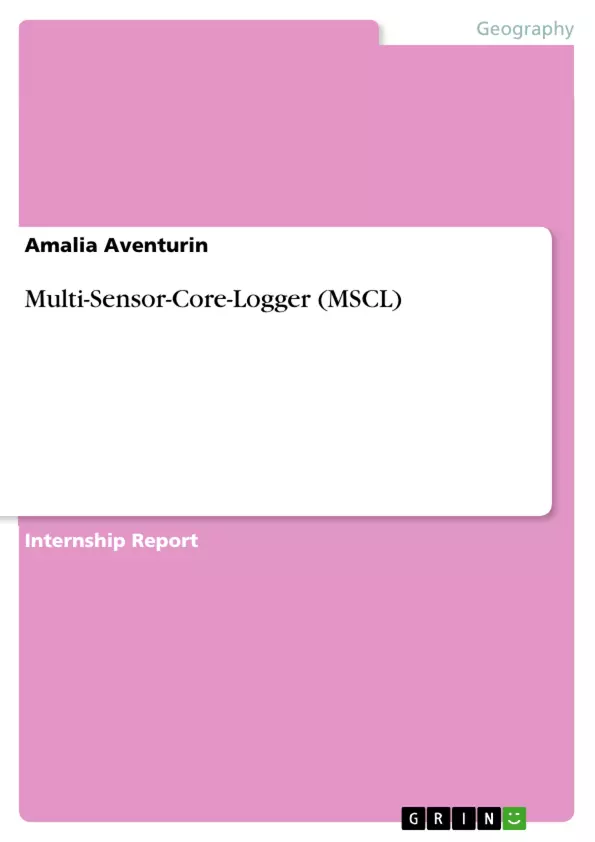The MSCL-experiment encloses the stepwise measurement of three different
parameters: Gamma density, P-wave-velocity (compressional wave travel time) and
magnetic susceptibility. Each is measured by different sensors. A photo of the
apparatus is shown in figure 1. The four core samples G1, a black stone, coarse-grained and compacted with small
mica particles and bigger white quartz inclusions, could be a gabbro and G2 a
greenish sandstone with small particles and lesser compaction, each unsaturated
and saturated with water are halved and “transported on a stepper motor-driven
tracking system” to the sensors. If the rock sample is heterogeneous and the halves
don’t accord in their mineral composition, you will have now a potential error source.
The samples are laid on the tracking system. A motor pushes them first to a laser,
where the length is measured, than to the gamma source and then to the P-wavevelocity-
sensor. Here you have a second potential error source: When the P-wavevelocity-
sensor presses the samples down for measuring, they were lift on the other
side. To avoid the lifting the rock samples have to be pressed and so the
measurements are not really accurate. [...]
Inhaltsverzeichnis (Table of Contents)
- I. Introduction: MSCL Principle
- II. Experimental measurements and Results
- II.1. Sample G1
- II.2. Sample G2
- III. Calculation
- IV. Error calculation
- V. Interpretation and Conclusion
- VI. References
Zielsetzung und Themenschwerpunkte (Objectives and Key Themes)
This document focuses on the Multi-Sensor-Core-Logger (MSCL) experiment, which measures gamma density, P-wave velocity, and magnetic susceptibility. It describes the methodology, results, and interpretation of measurements performed on two core samples: a gabbro (G1) and a sandstone (G2).
- MSCL Experiment: Methodology and Application
- Analysis of Core Samples: Gabbro and Sandstone
- Measurement of Physical Properties: Gamma Density, P-wave Velocity, and Magnetic Susceptibility
- Error Calculation and Interpretation
- Understanding the Relationship Between Physical Properties and Rock Composition
Zusammenfassung der Kapitel (Chapter Summaries)
- I. Introduction: MSCL Principle: This chapter introduces the MSCL experiment and describes the three parameters measured: gamma density, P-wave velocity, and magnetic susceptibility. It outlines the apparatus used and explains the process of measuring the samples, including the potential sources of error.
- II. Experimental measurements and Results: This chapter presents the experimental measurements and results obtained for the two core samples, G1 and G2. It describes the characteristics of each sample and the methods used to obtain the data.
- III. Calculation: This chapter details the calculations performed on the experimental data to determine the relevant parameters.
- IV. Error calculation: This chapter discusses the methods used to calculate the errors associated with the measurements.
Schlüsselwörter (Keywords)
The primary keywords and focus topics of this document include: Multi-Sensor-Core-Logger (MSCL), gamma density, P-wave velocity, magnetic susceptibility, core samples, gabbro, sandstone, error calculation, petrophysics, laboratory course.
- Arbeit zitieren
- Amalia Aventurin (Autor:in), 2013, Multi-Sensor-Core-Logger (MSCL), München, GRIN Verlag, https://www.hausarbeiten.de/document/272605


